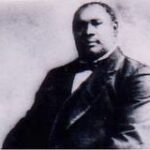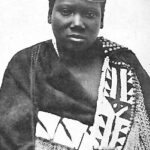KASONGO KINIAMA
- 5 Min Read
Kasongo Kiniama (circa 1850-circa 1890) was an African adventurer who participated in the slave trade to enrich himself and to advance his political ambitions. By trading slaves for guns, he was able to increase his power vis-à-vis weaker neighbours whom he terrorised and plundered. But, as other chiefs also began to sell slaves and purchase firearms, Kasongo Kiniama’s relative strength declined and eventually crumbled.
Kasongo Kiniama, born in the village of Kamaie, about 170 km (100 mi) southeast of modern Mbuji-Mayi, was the oldest son of Kalulu, chief of the Kamaie people. When Kasongo was about 15 years old, he learned of the presence of Swahili (Arab influenced) traders from the east coast of Africa, who were at the court of Kasongo Kalombo, the Luba Mulopwe (chief) near Lake Boya.
The young Kasongo Kiniama went to the Luba capital where the Swahili merchants hired him as a servant. Kasongo Kiniama accompanied his employers to Bunkeya (located about 65 km, or 40 mi, north of modern Likasi), the residence of Msiri the former east African trader who had settled in Shaba.
On his return in the late 1860s, he followed the Swahili merchants to Kabinda, court of the Bakalebwe, a sub-group of the Songye people. There the chief, Ya Kaumbu, father of Lumpungu had asked the Swahili traders for help to gain the submission of the Bakalebwe-related Tshofa people living about 130 km (80 mi) northeast of Kabinda.
After the Tshofa surrendered to Ya Kaumbu, Kasongo Kiniama left the Swahili traders and returned to Kamaie. With support from the Luba Mulopwe, he replaced his aged father as chief. To consolidate his power, he bought flint-lock rifles from the Cokwe, (Chokwe), Angolan traders who had entered the region a few years earlier.
Once he had collected enough arms, the young chief began attacking his weaker neighbours, the Budi, Gandu, Kileo, and Musoko. After victories against these groups, he crossed west of the Lubilash River and launched an offensive against the Kibetu, Muso-katshi, Poyo, Tshitolo, and northern Kanyok. Seeing Kasongo’s great strength, the Kalambaie, Shimba, and Cinene surrendered without a fight.
Because the people upon whom Kasongo Kiniama preyed had not yet acquired guns, the Luba adventurer’s victories were relatively easy. He was not able, however, to consolidate his triumphs into lasting political gains. For example, in the mid-1870s he came to the Kanyok capital, located 180 km (110 mi) south of modern Mbuji May on the Luilu River.
Finding the Kanyok central government weakened by schism, he attacked and killed the Kanyok leaders who had never before seen guns. Once Kasongo Kiniama tried to collect regular tribute, however, he met strong local resistance from Kanyok sub-chiefs. Marching 50 km (30 mi) south from the Kanyok capital to Etond village, his troops were ambushed. Many were killed while the others were forced to flee into the bush. From Etond, Kasongo Kiniama went north to the area around Gandajika, about 80 km (50 mi) southeast of modern Mbuji-Mayi. Here among the weaker, decentralised Luba people of Kasai, he was able to secure a capital at Musokatshi near Gandajika.
Placing his trusted assistant Hiam Kakoba in charge of Musokatshi, Kasongo sent his warriors to ambush and collect taxes from his subjects. To the chiefs who recognised him as suzerain he gave a rifle as a sign of their authority; other chiefs he replaced with his own followers.
From the beginning of his conquests, Kasongo Kiniama had refused to pay tribute to the Luba Mulopwe, Kasongo Kalombo, his nominal suzerain. Thus, in 1885, the Mulopwe assembled his armies and crossed the Lomami River where he conquered Kamaie, Kasongo Kiniama’s natal village. Kasongo Kiniama’s brother, who fled Kamaie, managed to save himself, but he could not stop the Luba from crossing Kamaie territory and plundering the Bala and the Bakoshi on the Lumbebi River, as well as the Kibundji, Kibetu, and Mpata north of the Sankuru River, and also the Niko. From there he turned his attention to northern Kanyok. On the following day, however, the Kanyok launched a counter-attack and recaptured many of their people who had been taken prisoner. Not wanting to expose himself too much to the Kanyok, who were superior in numbers, the Mulopwe renounced his pursuit of Kasongo Kiniama and returned to his own land. Kasongo Kiniama, it is said, fled to the Lunda, where he hoped to buy gunpowder. He returned to the Lubilash area only after the Mulopwe’s departure.
In the late 1880s, Kasongo Kiniama tried to acquire more rifles, in order to consolidate his authority over the numerous populations between Kamaie and Lubilash. In addition, he wanted additional guns to protect against Swahili troops who were harassing Lumpungu in the north. Thus, in 1889 or 1890, Kasongo Kiniama journeyed west to the Luba Kasai chief, Kasongo Lwaba, known as Fuamba, who lived 65 km (40 mi) southeast of modern Kananga. From Fuamba, he hoped to obtain guns and powder the Kasai Luba had bought from the Cokwe. Kasongo failed in his mission and had to retreat in the face of Fuamba’s menacing attitude.
During Kasongo Kiniama’s absence, Kabw Muzemb, chief of the Kanyok rallied the people around Musokatshi to revolt against Hiam Kakoba who had remained behind at the capital. When the attack failed, Kabw Muzemb retreated to the safety of his own land. On his return, Kiniama began a reprisal against his own disobedient subjects. He was killed, however, by the Nsona villagers who feigned support for the angry slave merchant.
His death, followed by the retreat of his people, marked the break-up of his fief. It was also followed, in late 1891, by the famous bloody invasion by Ngongo Leteta instigated by Nomena a Mukulu, first wife of Kasongo Kiniama. Sworn to avenge her husband’s death, Nomena first asked Lumpungu for help. When he refused, she went to Ngongo Leteta, who came to fight and plunder the rebel villages around Musokatshi.
MUTEBA KABEMBA




